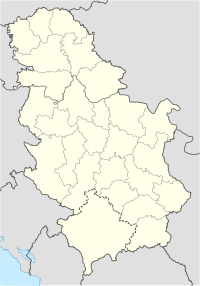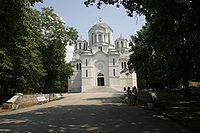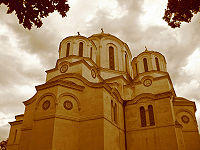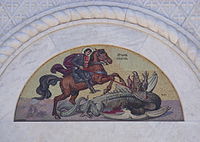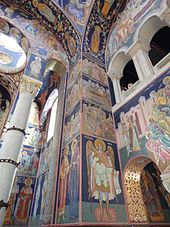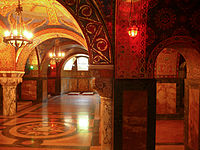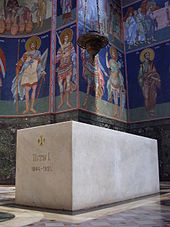- Oplenac
-
Oplenac Црква Опленац 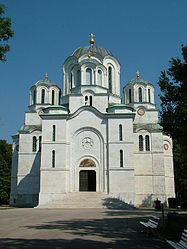
Church Oplenac44°15′N 20°40′E / 44.25°N 20.667°E Location Topola Country  Serbia
SerbiaDenomination Eastern Orthodoxy Website http://www.oplenac.rs/home_eng.html History Founded 1910 Founder(s) Peter I of Serbia Dedication Saint George Architecture Status Church Functional status Active Heritage designation Monument of Culture of Exceptional Importance Designated 1979 Style Morava Architectural Style Specifications Number of domes 1 Materials Stone St. George′s Church (Serbian Cyrillic: Црква Св. Ђорђа) knows also as Oplenac Church and Oplenac Mausoleum, is the Mausoleum of the Serbian and Yugoslav Royal House of Karađorđević located on top of the Hill Oplenac in city Topola, Serbia. The Foundation in Oplenac is named after King Peter I of Yugoslavia.
Contents
The mausoleum
Apart from the two tombs inside the church (Karađorđe’s in the southern apse; and King Peter I in the northern apse), there are 20 other members of the Dynasty whose eternal place of rest is in this Mausoleum. Six generations of the Karađorđević family have been buried in this church. The first generation is Marica (born Živković), Karađorđe's mother. The second generation is Karađorđe (in the tomb in the church), and his wife Jelena (1764–1842); the third generation is Karađorđe’s son Prince Alexander, and his wife Princess Persida Nenadovic (1813–1873); the fourth generation – the nine children of Prince Alexander and Princess Persida, as follows: Kleopatra (1835-1855), Aleksije (1836-1840), Svetozar (1841-1847), King Peter I (in the tomb in the church), whose wife Princess Ljubica also known as Zorka (1864–1890), former Princess of Montenegro, is buried here in the crypt; moving on with Prince Alexander’s children: Jelena (1846–1867), Andreja (1848–1864), Jelisaveta (1851–1852), Đorđe (1856–1888), and Arsenije (1859–1938). The fifth generation, the children of King Peter I and Princess Zorka : Milena (1886–1887), Đorđe (1887–1972), his wife Radmila (born Radović, 1907-1993); King Alexander I of Yugoslavia (1888–1934), Andrija (1890–1890 – lived only for 23 days). The sixth generation: son of King Alexander I of Yugoslavia – Prince Tomislav (1928–2000).
Out of the ten children of Prince Alexander and Princess Persida, only their oldest daughter, Poleksija (1833–1914), was not buried here. Out of the 22 tombs of the Karađorđević Dynasty, four of them belong to rulers: Supreme Leader Karađorđe, Prince Alexander, King Peter I, and King Aleksandar I. It is an important place of Serbian history.
The History of Oplenac
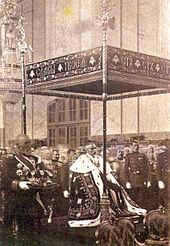 Coronation of King Peter I in St. Michael's Cathedral, Belgrade on 1904.
Coronation of King Peter I in St. Michael's Cathedral, Belgrade on 1904.
In the 19th century this area was covered in woods. The term Oplenac most probably derives from "oplen", meaning wooden parts on ox cars. Karađorđe had settled here, built vineyards and orchards, and established the defence of the nearby Topola town. His son Alexander built new buildings and renewed his father’s vineyards and orchards. It was not until the arrival of King Peter I of Serbia that this place got its true importance.
Peter I, upon assuming Royal Duties in 1903, chose a spot 337 metres (1106 ft) on the top of Mali Oplenac for the location of his St. George Church. The location was measured by geodesy experts; so the altar would face east according to Orthodox tradition. In 1907 the cornerstone was laid, and the Charter dedicated to St. George was placed in the foundation. The winning prize for the tender was given to architect Nikola Nestorović. After a long and animated expert discussion, primarily regarding the demand for the monumentality of the Serbian-Byzantine style, and due to the King’s own displeasure with the proposed solution, another tender in 1909 was launched. The committee was made up with basically the same previous members (Mihailo Valtrović, Andra Stevanović, and architect Konstantin A. Jovanović, who replaced Dragutin Đorđević from the previous committee).
The committee awarded first prize to the young architect Kosta J. Jovanović. On May 1, 1910 construction started following the Kosta J. Jovanović’s plan. For four months stone breaking lasted for the crypt and the foundation of the church. On September 1, 1910, the foundation was mostly completed. In 1911 the building process continued at a fast rate, and the church was already under the dome. It was decided that same year that the façade of the church would be made of white marble, which came from nearby Venčac Mountain, even today known for its exceptionally white beautiful marble. In the autumn of 1912 the church was generally complete and ready for consecration. The Serbian Archbishop Dimitrije consecrated the church on September 23, 1912. During pauses of the 1912-1913 Balkan Wars and the First World War, there was also a pause in the construction of the church. When Austria-Hungary occupied Serbia in the winter of 1915, the church was looted – the copper cover was removed from the dome, roof and portals. The lighting conductor was also removed as well as the bells. Many windows were broken including little marble pillars and ornaments. Using the excuse that important records might be hidden the occupiers desecrated the graves in the crypt.
Returning to the liberated homeland and to the historical creation of the Kingdom of Serbs, Croats and Slovenes, Peter I was not able to see completion of his foundation. The king died on August 16, 1921, and his successor Aleksandar I took over its completion. He modified the original plan.After the reconstruction of the crypt, by Kosta J. Jovanović, this was followed by the iconostasis, the lightning conductor, then a new copper roof with golden edges on the dome. The bells were made by Frères Piccard from Annecy le Vieux, France and the mosaics were made by Puhl & Wagner from Berlin, Germany. The bronze chandelier was made by Luks, Zagreb, Croatia. The church was once again consecrated in September 1930. Church services were held until 1947. After that it was declared an exceptional cultural monument and open to visitors. Oplenac was added to Monument of Culture of Exceptional Importance list in 1979, and it is protected by Republic of Serbia.[1]
The architecture and design of the church
The church is a five-domed structure. The interior length of the temple is 30 metres (98 ft), and the height of the arch is 27 metres (89 ft). The width of each narthex is 9 metres (29 ft), and so is the span of the central dome. All four façades were made from white marble, which comes from the Venčac Mountain. The main façade, the most decorative one, is the western one. The portal’s semicircle hosts a mosaic icon of St. George, to whom the church is dedicated. Made in Venice according to the plan of the known Serbian artist, Paja Jovanović, on the basis of a golden mosaic, this icon symbolizes the victory of the Serbian people over its enemies. Above the portal, in a circle, the old Karađorđević Family Coat of Arms has been sculpted, on whose sides two typical men from Šumadija region are shown, holding the flags. The rest of it is mostly identical to the Coat of Arms of Serbia. The floor of the church was made in Munich, out of polished marble, in various colours. Lifted on a small podium, the throne for the King and Queen is made of polished green marble, its back is decorated with golden mosaic and mother-of-pearl, in the middle is the two-headed eagle. The arm-rest is made of marble from Dečani, while the entire seat rests on sculpted lions. The huge chandelier, 9 metres in diameter, is underneath the main dome, hanging in 8 places, above the pendent. It has been molten out of massive bronze, and weighs 1500 kilograms (3300 lb). In the chandelier is a Crown set upside-down (symbolising the lost Serbian Empire in Kosovo battle in 1389).
The mosaic
The initial idea of King Peter I was to carve into the walls the names of all soldiers and officers who had perished in the Balkan Wars of 1912 and 1913. But, since the church was not fully completed, and since First World War followed (1914-1918), this idea had to be abandoned. The solution was to decorate the interior of the temple with mosaics, which would be a sort of a museum of reproductions of the prettiest frescoes of the Serbian medieval arts. Copies from 60 Serbian medieval churches and monasteries had been brought to the St. George church at Oplenac. The entire mosaic has 725 painted compositions (513 in the temple and 212 in the crypt), on which there are 1500 figures. The entire area of the mosaic is 3,500 square metres (38,000 sq ft); with 40 million various coloured pieces of glass which have 15 thousand different varieties of colour, making the most vivid artistic impression.
To the right side of the entrance, on the entire southern wall of the narthex, is the Painting of the Trustee, of King Peter I holding the model of his church on the palm of his left hand, wearing a crown and coronation ornaments. With his right hand, he is guided by St. George, to whom the temple is dedicated, and shown approaching the Mother of God, greeting him with Christ sitting on the throne.
Tomb of King Peter I of Serbia.
In the southern apse is the Gallery of the Serbian Medieval Rulers, an impressive line-up, with every one of them represented by their respective churches. The first on the left is Stefan Nemanja (Grand Duke, ruled from 1168 to 1196), wearing a priest garb of the Hilandar monastery, holding the Studenica monastery. Then, there is King Stefan the First Crowned (1196-1227) with the model of the Žiča monastery, then King Stefan Radoslav (1227–1234) with the narthex of Studenica monastery, followed by King Stefan Vladislav (1234–1243) with the Mileševa monastery, then King Stefan Uroš I (1243–1276) with the Sopoćani monastery; King Stefan Dragutin with the Arilje monastery (1276–1282), King Stefan Milutin (1282–1322) with the Gračanica monastery, King Stefan Dečanski (1322-1331) with the Visoki Dečani monastery, and two Tsars – Dušan The Mighty (1331-1355) with the Prizren church of St. Archangels; and Uroš The Weak (1355–1371), with the Matejić monastery near Kumanovo. The next depicted ruler, titled formally as Prince and informally as Tsar, was Lazar of Serbia(1371-1389) with the Ravanica monastery, his son Despot Stefan (1389–1427) with the Manasija monastery, followed by Despot Đurađ, with the church of Smederevo.
In the very calotte of the main dome is the Pantocrator (the Almighty Jesus Christ), copy of the thorax found in the Gračanica monastery. The face of Christ, 27 metres from the floor of the temple, looks very impressive and is of proportional dimensions. Although the diameter of this painting is 9 metres (29 ft) long, and although just the finger of Christ is 1.5 metres (5 ft) long, and the nose is 1.2 metres (4 ft) long, everything is harmonious. In the altar are the frescoes Lord's Supper and The way to the Golgotha. In the altar niche there is the 5-metre (16 ft) tall figure of the Divine Mother of God in a praying position (copy of the fresco from the Peć Patriarchate). Also, there is the Secret of the Holy Communion and the Communion of the Apostles with Bread and Wine.
These are just some of the compositions that make the rich interior of the church.
Besides the Mausoleum (St. George church), there are other objects that encompass the Foundation of King Peter I – King Peter's House, King’s villa, Queen’s villa, Vineyards, Vineyard Keeper’s House, etc. Visitors can also visit the historic town of Topola located nearby, a traditional stronghold of the Karađorđević family, ever since the time of Karađorđe, Leader of the First Serbian Uprising of 1804. There they can see what remains of the old Topola town, Karađorđe’s church and Karađorđe’s monument.
See also
- Monument of Culture of Exceptional Importance
- Tourism in Serbia
External links
- Mausoleum The Mausoleum of the Serbian Royal Family
Notes and references
- ^ Monuments of Culture in Serbia: КАРАЂОРЂЕВА ТОПОЛА СА ОПЛЕНЦОМ (SANU) (Serbian) (English)
Cultural Heritage of Serbia 
Archaeological sites Archaeological Sites of Exceptional Importance • Archaeological Sites of Great Importance • Protected Archaeological Sites
Monuments of Culture Monuments of Culture of Exceptional Importance • Monuments of Culture of Great Importance • Protected Monuments of CultureHistoric Landmarks Historic Landmarks of Exceptional Importance • Historic Landmarks of Great Importance • Protected Historic LandmarksSpatial Cultural-Historical Units Spatial Cultural-Historical Units of Exceptional Importance • Spatial Cultural-Historical Units of Great Importance • Protected Spatial Cultural-Historical UnitsCategories:- Cultural Heritage of Serbia
- House of Karađorđević
- Monument of Culture of Exceptional Importance
- Serbian architecture
- Buildings and structures in Serbia
- 1930s establishments
- Šumadija District
Wikimedia Foundation. 2010.

